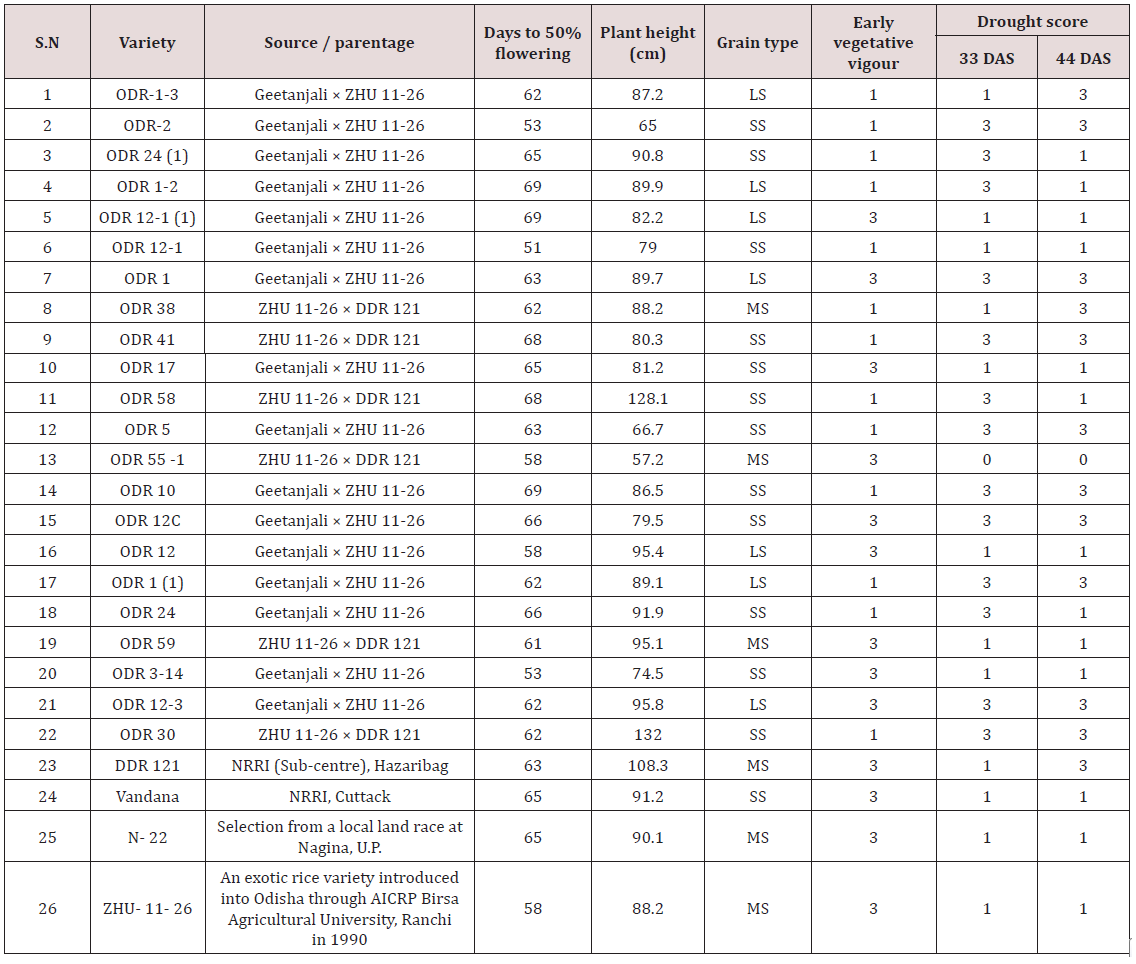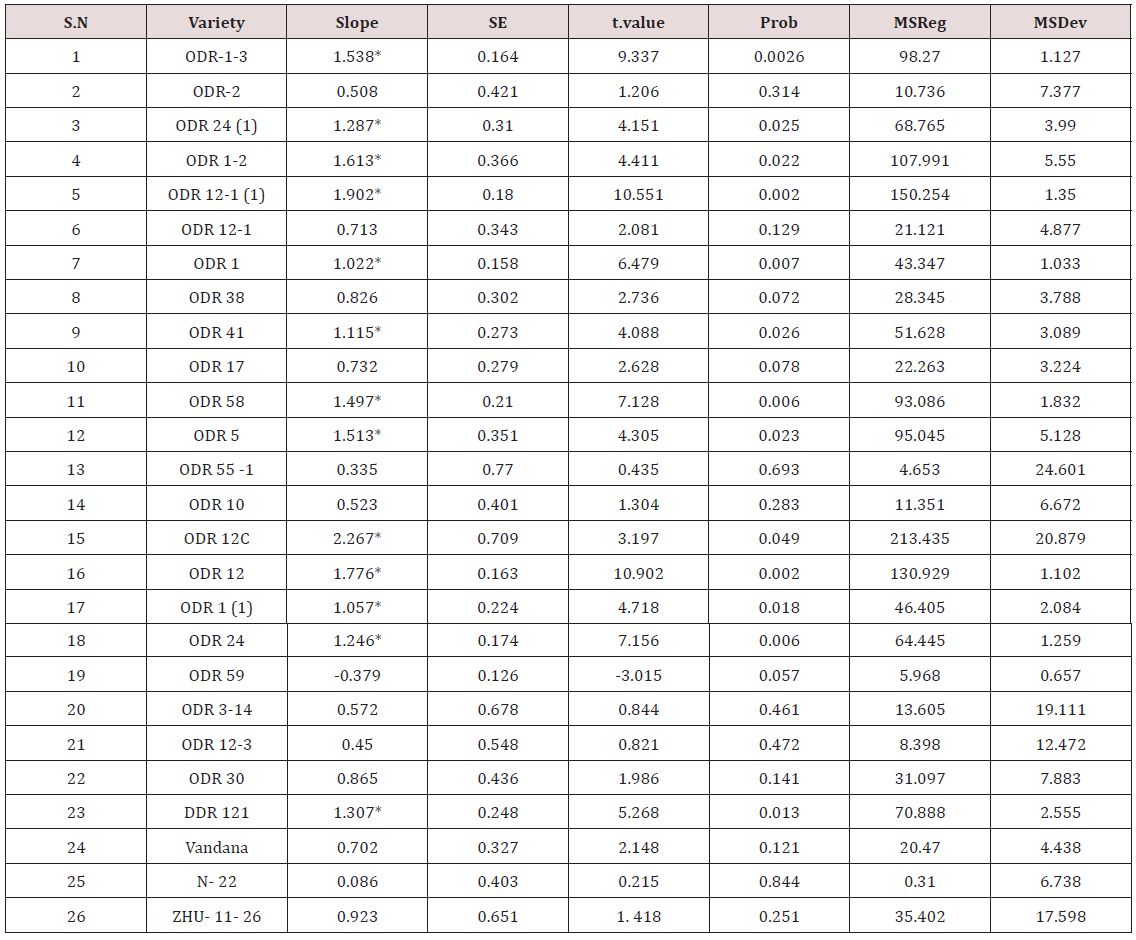Lupine Publishers | Current Investigations in Agriculture and Current Research
Abstract
A field experiment was carried out at All India Coordinated Research Project for Dryland Agriculture, Orissa University of Agriculture and Technology, Phulbani to evaluate the newly developed early maturing rice genotypes and estimate their yield stability. The trial was laid out in randomized block design with three replications for 5 years from 2012 to 2016 involving 26 rice genotypes including-(a) 22 improved lines from AICRP for Dryland Agriculture, OUAT, Phulbani (ODR lines; ODR denotes ‘Odisha dryland rice’), (b) one line from NRRI sub-centre, Hazaribag, DDR-121, (c) one exotic variety, ZHU 11-26 and (iv) two varieties from NRRI, Cuttack, Vandana and N-22. Another set of experiment was carried out at ICAR-National Rice Research Institute, Cuttack to evaluate the response of the genotypes towards drought stress. Highest mean grain yield was recorded in ODR 12-3 (30.43 q/ha) followed by ODR 12C (27.42 q/ha) and ODR 41 (27.22 q/ha). ODR 12C exhibiting high mean yield along with highest slope can be considered most adaptable. Long slender aromatic genotypes such as ODR 1, ODR 1-1, ODR 1-2 and ODR 1-3 had also high yield coupled with slope >1.0, thus exhibited high stability. Drought score (DS), performed on the basis of Standard Evaluation System (SES) scale, showed that ODR-55(1) is highly drought tolerant on the basis of leaf rolling and drying character (SES=0).
Keywords: Rice; Rainfed; Drought score; Yield stability
Introduction
Rice is the staple food for over 90% population of the Asiatic countries. It is the principal source of energy for the people of Asia, Latin America and pacific islands [1]. It has a distinct position among cereal crops due to its capacity for being cooked and consumed as whole grains [2] and quality assumes great significance. It is also the source of livelihood for a majority of people of India, China and some other countries. Rice cultivation is one of the major providers of rural employment. However, shortage of water in many rices growing countries of the world is gradually increasing with simultaneous decrease in crop yield [3]. Upland rice, covering over 9 million hectares in Asia, is subjected to multiple abiotic stresses, drought being the number one, occurring almost regularly, limiting crop productivity and farmers’ income. In this context, increasing productivity of rice in all eco-systems assumes a great challenge as one-sixth of the global population is deprived of enough food and remains hungry or under-nourished.
Since the commencement of green revolution during late 1960s, rice production in India has become trebled and it is important to maintain the increasing trend in future. However, rice cultivation is considered non-remunerative in many parts of India particularly in rainfed uplands due to frequent crop failure during long dry spells. Still then, in several locations of the states like Odisha, West Bengal, Chhatisgarh, etc. people are reluctant for crop diversification in uplands during kharif (S-W monsoon) season and traditionally grow rice. Many farmers use local short durational rice varieties which mature in 80-90 days and escape terminal drought. In years with early or mid-season drought, these varieties fail to give satisfactory yield. Again, long slender scented rice varieties which could fetch high market price are not available for upland situation.
Rice is the main crop of Odisha including hilly districts like Kandhamal and is grown in all types of land. In Kandhamal district, 80% of the cultivated area is upland without irrigation facility where only short durational drought tolerant/escaping genotypes can be grown. The productivity of local variety is low. In N-E ghat zone of Orissa, the annual rainfall is quite high (above 1400mm), but the distribution is quite erratic and dependable monsoon occurs only for 3 months. Due to sandy/sandy-loam soil texture in uplands, rice crop suffers severely from dryspells lasting for a week. Again, the yield and quality of local type of rice grown in uplands of Kandhamal is not so good from marketing point of view. Thus, availability of short durational, drought tolerant, high yielding and good quality rice variety which will be acceptable by the farmers is needed to increase the net income. Therefore, crop improvement programmes were initiated at All India Coordinated Research Project for Dryland Agriculture from 2006-07 to develop suitable rice varieties for rainfed upland system. The present investigation highlights the yield stability of twenty-six rice genotypes suitable for upland with required features like 1. Short duration, 2. Long slender aromatic grain (Basmati type), 3. High yield, 4. Drought tolerance, and/or 5. Disease pest resistance in order to assure high and stable yield as well as better price for the produce.
Materials and Methods
Site description: The soil at the experimental site had Sandyloam Texture with pH 5.22 and average N, P2O5 and K2O content of 123, 32.1 and 164.9kg/ha, respectively. The normal rainfall of the location is 1407.34mm. The annual and cropping season rainfall with dry spells affecting growth and productivity at the experimental site in different years has been presented in Table 1.
Planting material
Twenty-six rice genotypes including 22 improved lines from AICRP for Dryland Agriculture, OUAT, Phulbani (ODR lines; ODR denotes ‘Odisha dryland rice’), one line from NRRI sub-centre, Hazaribag obtained for evaluation during 2004 (DDR-121), one exotic line from Birsa Agriculture University obtained for evaluation during 1990 (ZHU 11-26) and two lines from NRRI, Cuttack (Vandana and N-22) generally considered as drought tolerant checks, were utilized in the present investigation (Table 2). ZHU 11-26 and DDR-121 were parents of ODR lines. Geetanjali, although a parent, was excluded from this study due to medium maturity duration (130 days). It was used in the hybridization programme for transferring the grain characters (long slender aromatic). Pedigree method of breeding was followed to develop ODR lines.
Experimental plan
The test genotypes were grown under rainfed upland situation during kharif season in the research farm of AICRP for Dryland Agriculture, OUAT, Phulbani for 5 years from 2012 to 2016. The experiment was laid out in randomized block design with three replications. The crop was sown in lines 20 cm apart during last week of June with a fertilizer dose of 60-30-30 kg N-P2O5-K2O. Recommended agronomic practices were followed to raise the crop. A separate experiment was conducted at National Rice research Institute, Cuttack during 2016 to elucidate the reaction of genotypes to drought stress under rainout shelter. Data on early vegetative vigour and drought stress at 33 and 44 days after sowing were recorded (Table 2). Drought stress tolerance was measured in 0-5 scale; 0=very high drought tolerance, 1=high drought tolerance, 3= moderate drought tolerance, and 5=drought susceptible.
Data analysis
The grain yield data over five years was utilized for stability analysis following Finlay Wilkinson model (1963) [4] using PB Tools, version 1.4. 2014 developed by IRRI, Philippines [5]. As per this model, slope of the regression is a measure for adaptability. The average slope equals unity, indicating average adaptability; genotypes with slopes > 1.0 have higher than average adaptability (with greater resistance to environmental changes); and genotypes with slopes < 1.0 have lower than average adaptability.
Results and Discussion
Drought is a serious abiotic stress for rice production and many popular varieties are drought susceptible [6]. Research on quantitative trait loci (QTL) conferring drought tolerance show that QTLs, primarily contributing towards stable yield under drought stress directly or via secondary traits such as root characteristics and leaf rolling, have relatively small effects and different QTLs have been detected in different studies [7,8]. Some QTLs help in significantly increasing water uptake under drought stress and stabilize grain yield [9,10]. Attempts have been taken to identify such useful QTLs in crosses involving popular varieties like Swarna to increase their potential for cultivation in drought-prone environments [11]. Among different genotypes, ODR 12-1 took minimum number of days to 50% flowering closely followed by ODR-2 and ODR-3-14 (Table 2). Three genotypes flowered within 55 days, three between 55-60 days, 13 genotypes between 60- 65 days, and rest 7 genotypes between 65-70 days. ODR-1, ODR- 1-1, ODR-1-2 and ODR-1-3 had long slender grains with aroma, thus expected to fetch better market price. They took less than 65 days for 50% flowering and possessed high or moderate drought tolerance.
The plant height of different genotypes varied from 57.2 cm in ODR 55-1 to 132 cm in ODR-30. All genotypes had slender grains and were grouped into three categories, such as long slender (LS), medium slender (MS) and short slender (SS). In spite of quite sufficient crop seasonal rainfall in several years, the distribution was erratic with dry spells at critical growth stages that could affect the crop growth and productivity. Significant variation was observed among the test genotypes for grain yield in all the five years (Table 3). Highest mean grain yield was recorded in ODR 12-3 (30.43q/ha) followed by ODR 12C (27.42q/ha) and ODR 41 (27.22q/ha). ODR 12C exhibiting high mean yield along with highest slope (Table 4) can be considered most adaptable. Long slender aromatic genotypes such as ODR 1, ODR 1-1, ODR 1-2 and ODR 1-3 had also high yield coupled with slope >1.0, thus exhibited high stability. Under rainfed upland ecosystem, availability of such high-quality genotypes seems to enhance profitability of rice farming particularly of tribals in hilly tracts. Among these 4 types, ODR 1-2 had high drought tolerance at 44 days after sowing under rain out shelter situation and thus could be advocated for drought prone areas. All other genotypes having comparatively higher grain yield and slope > 1.0 may also be recommended for rainfed uplands.
A crop like rainfed (kharif) rice is more sensitive to rainfall than temperature. In future, water availability is likely to be reduced and soils of high water holding capacity [12] and use of drought tolerant varieties may play an important role in maintaining crop yield. Drought score (DS), performed on the basis of Standard Evaluation System (SES) scale, showed that ODR-55(1) is highly drought tolerant on the basis of leaf rolling and drying character (SES ‘0’). Since the phenotypic performance of a variety may not be same under different agro-ecological situations due to the influence of environment on genotype, information on phenotypic stability holds a great promise. Stability of a variety enables it to remain unaffected by environmental changes [13]. The aromatic long slender rice genotypes are expected to increase the net income of farmers due to high market price of the produce. Almost 100 volatile compounds have been reported to be responsible for basmati flavor which includes 13 hydrocarbons, 14 organic acids, 13 alcohols, 16 aldehydes, 14 ketones, 8 esters, 5 phenols, etc. [14,15]. The principal compound responsible for aroma, 2-Acetyl- 1-pyrroline (2AP), has been detected in the whole above ground plant parts of scented rice [16,17]. In addition to 2AP, several other volatile compounds contributing to the aroma of scented rice cultivars, such as hexanal, nonanal, octanal, decanal, guaicol, indole and vanillin, have been identified [18, 19]. Even in absence of the estimates on aroma, the aromatic long slender genotypes used in the present study with high drought tolerance and stability need attention for rapid spread across locations.
Conclusion
The present investigation highlights the stability of new rice genotypes varying in grain type, aroma, duration and grain yield to justify their suitability for cultivation in rainfed uplands. The genotypes exhibiting 50% flowering within 55 days are expected to escape drought, frequently occurring towards end of monsoon season although they may not possess adequate drought tolerance. The genotypes with high mean grain yield, slope >1.0 and good grain quality like ODR 1-2 are to be adopted for rainfed upland conditions of Odisha in order to improve the economic condition of rice farmers.
Read More Lupine Publishers Agriculture Journal Articles:





No comments:
Post a Comment
Note: only a member of this blog may post a comment.